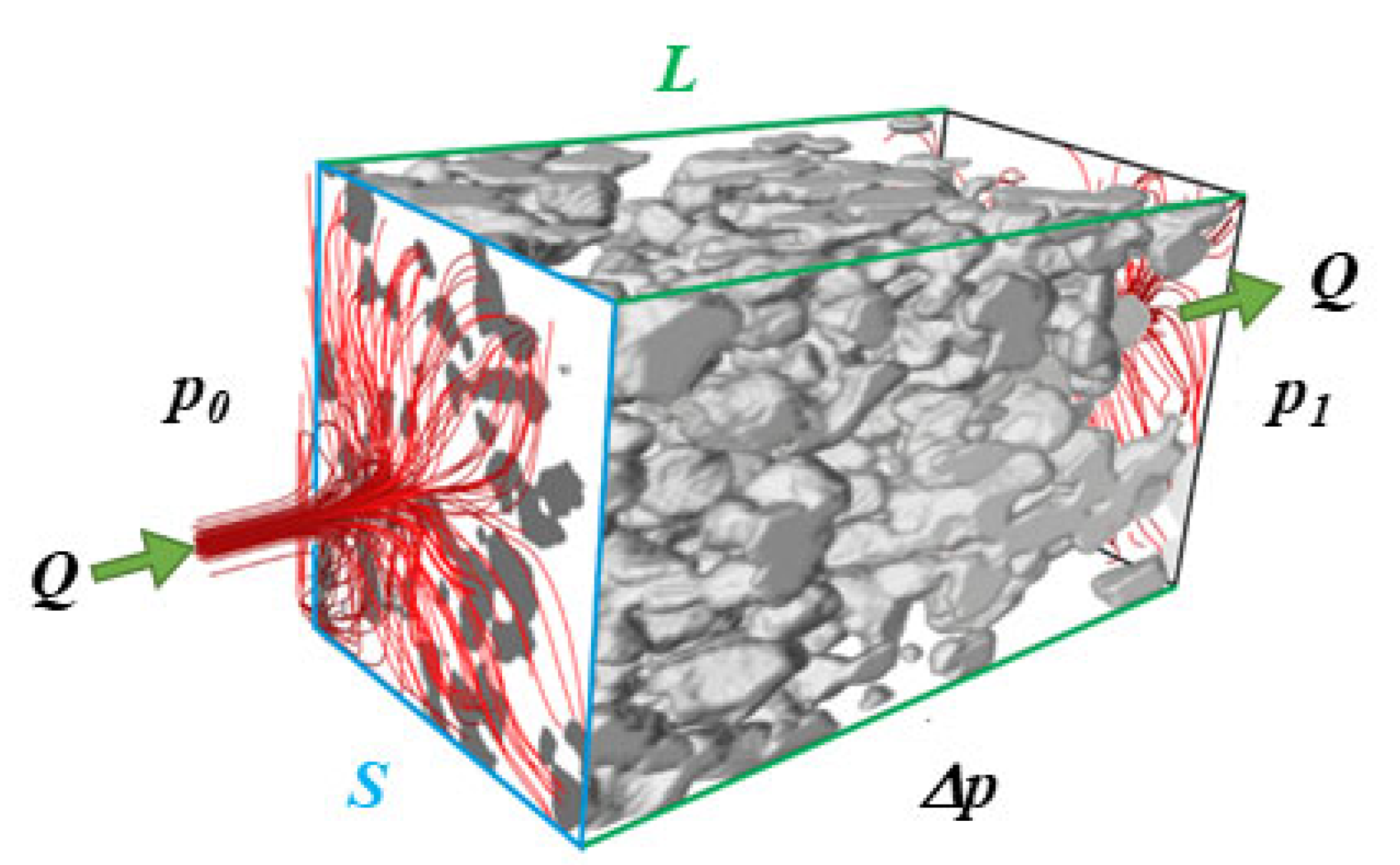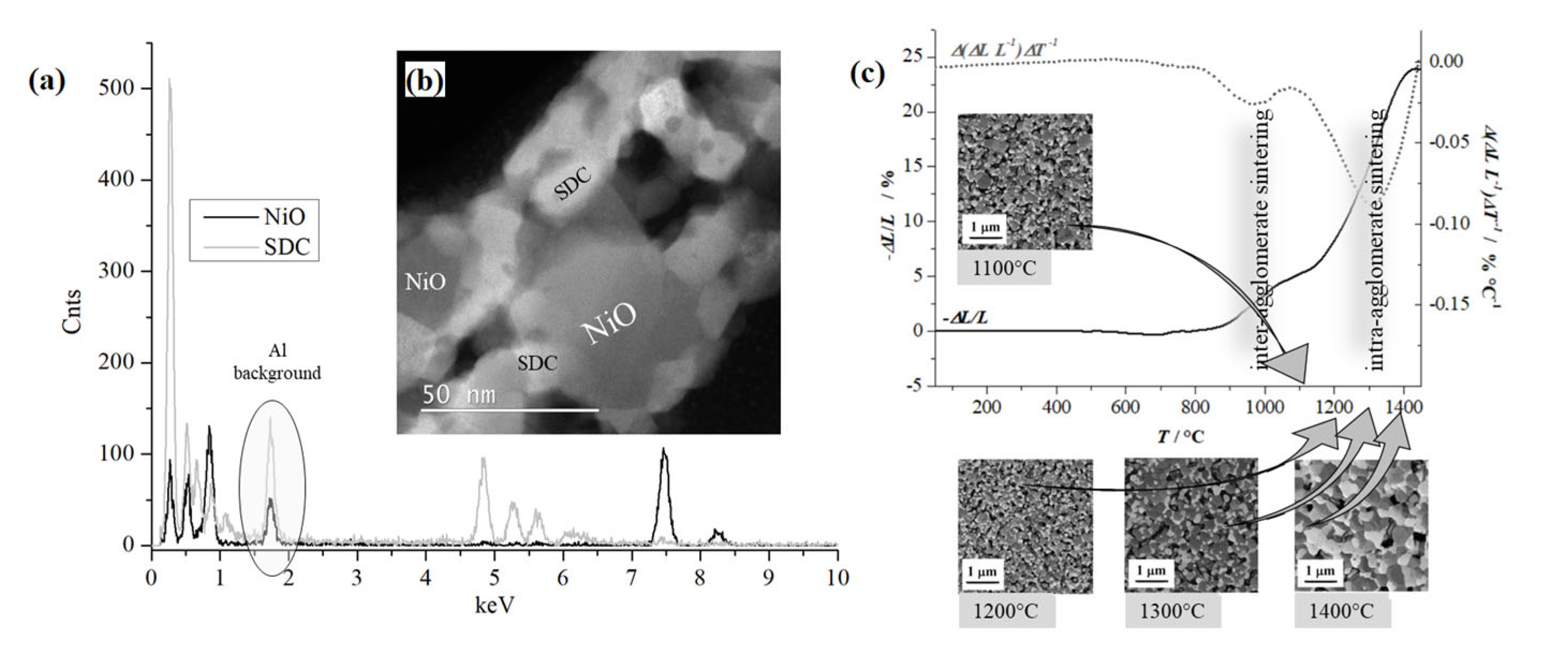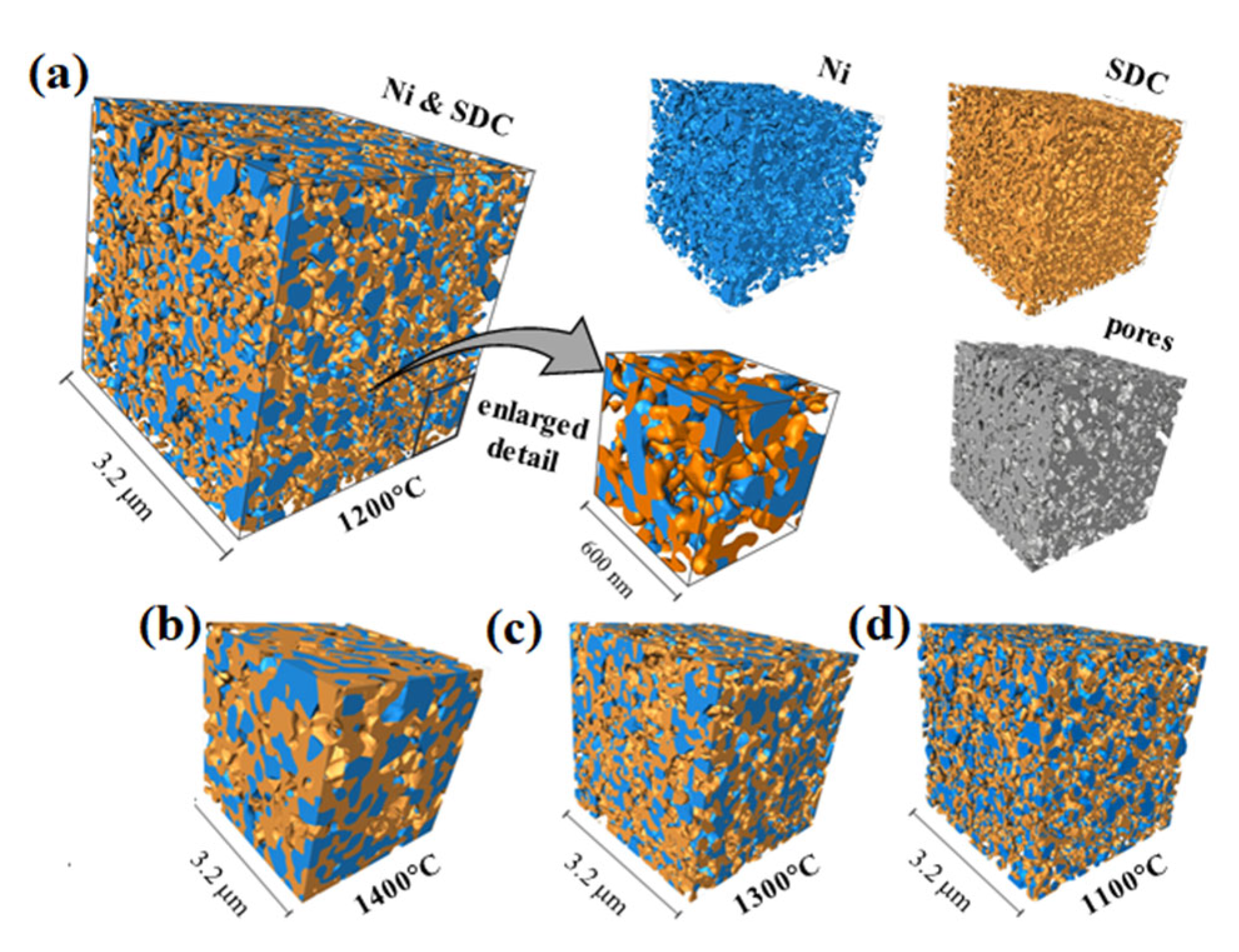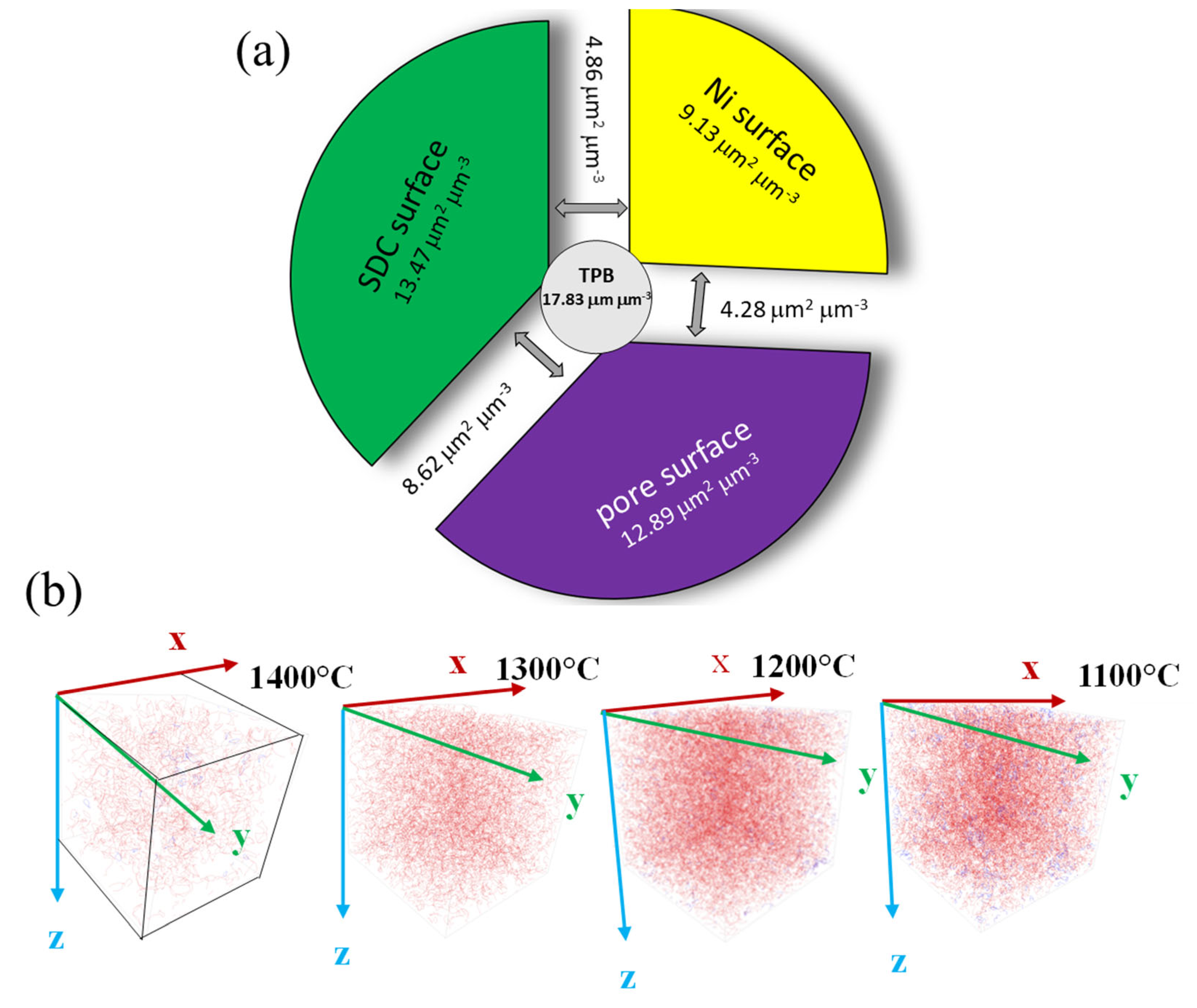The Microstructural Reconstruction of Variously Sintered Ni-SDC Cermets Using Focused Ion Beam Scanning Electron Microscopy Nanotomography
Abstract
:1. Introduction
2. Materials and Methods
2.1. Sample Prepaartion
2.2. Characterization Techniques
2.3. Microstructural Measurements
2.3.1. FIB-SEM Sample Preparation
2.3.2. FIB-SEM Imaging
2.4. Three-Dimensional Data Processing
2.4.1. Three-Dimensional Image Processing
2.4.2. Segmentation and 3D Reconstruction
2.5. Three-Dimensional Quantification of Porous Microstructure
2.5.1. Volume Fractions
2.5.2. Size Distribution
2.5.3. Specific Surface and Specific Interfacial Areas
2.5.4. Phase Connectivity
2.5.5. TPB Calculations
2.5.6. Tortuosity
2.5.7. Absolute Permeability
3. Results and Discussion
4. Conclusions
Supplementary Materials
Author Contributions
Funding
Institutional Review Board Statement
Informed Consent Statement
Data Availability Statement
Conflicts of Interest
References
- Tian, D.; Liu, W.; Chen, Y.; Yu, W.; Yu, L.; Lin, B. A robust NiO–Sm0.2Ce0.8O1.9 anode for direct-methane solid oxide fuel cell. Mater. Res. Bull. 2015, 71, 1–6. [Google Scholar] [CrossRef]
- Lee, H.-W.; Park, M.; Hong, J.; Kim, H.; Yoon, K.J.; Son, J.-W.; Lee, J.-H.; Kim, B.-K. Constrained Sintering in Fabrication of Solid Oxide Fuel Cells. Materials 2016, 9, 675. [Google Scholar] [CrossRef] [PubMed]
- Su, H.; Wu, D.; Li, C.; Li, C.; Zhang, C. Research advances on electrode materials for solid oxide electrolysis cells. Prog. Nat. Sci. Mater. Int. 2023, 33, 309–319. [Google Scholar] [CrossRef]
- Araújo, A.J.M.; Grilo, J.P.F.; Loureiro, F.J.A.; Holz, L.I.V.; Macedo, D.A.; Fagg, D.P.; Paskocimas, C.A. Proteic sol–gel synthesis of Gd-doped ceria: A comprehensive structural, chemical, microstructural and electrical analysis. J. Mater. Sci. 2020, 55, 16864–16878. [Google Scholar] [CrossRef]
- Lyu, Y.; Xie, J.; Wang, D.; Wang, J. Review of cell performance in solid oxide fuel cells. J. Mater. Sci. 2020, 55, 7184–7207. [Google Scholar] [CrossRef]
- Léon, A.; Schlabach, S.; Villanova, J. X-ray nano-spectroscopy study of two solid oxide cells operated for long-term in steam electrolysis. J. Power Sources 2023, 581, 233410. [Google Scholar] [CrossRef]
- Komorowska, G.; Wejrzanowski, T.; Jamroz, J.; Jastrzębska, A.; Wróbel, W.; Tsai, S.-Y.; Fung, K.-Z. Fabrication and Characterization of a Composite Ni-SDC Fuel Cell Cathode Reinforced by Ni Foam. Materials 2022, 15, 4891. [Google Scholar] [CrossRef] [PubMed]
- Gorte, R.J.; Vohs, J.M. Nanostructured anodes for solid oxide fuel cells. Curr. Opin. Colloid Interface Sci. 2009, 14, 236–244. [Google Scholar] [CrossRef]
- Shikazono, N.; Kanno, D.; Matsuzaki, K.; Teshima, H.; Sumino, S.; Kasagi, N. Numerical Assessment of SOFC Anode Polarization Based on Three-Dimensional Model Microstructure Reconstructed from FIB-SEM Images. J. Electrochem. Soc. 2010, 157, B665. [Google Scholar] [CrossRef]
- Liu, Q.; Dong, X.; Yang, C.; Ma, S.; Chen, F. Self-rising synthesis of Ni–SDC cermets as anodes for solid oxide fuel cells. J. Power Sources 2010, 195, 1543–1550. [Google Scholar] [CrossRef]
- Wargo, E.A.; Kotaka, T.; Tabuchi, Y.; Kumbur, E.C. Comparison of focused ion beam versus nano-scale X-ray computed tomography for resolving 3-D microstructures of porous fuel cell materials. J. Power Sources 2013, 241, 608–618. [Google Scholar] [CrossRef]
- Yang, J.; Heogh, W.; Ju, H.; Kang, S.; Jang, T.-S.; Jung, H.-D.; Jahazi, M.; Han, S.C.; Park, S.J.; Kim, H.S.; et al. Functionally graded structure of a nitride-strengthened Mg2Si-based hybrid composite. J. Magnes. Alloys 2024, 12, 1239–1256. [Google Scholar] [CrossRef]
- Zhu, W.Z.; Deevi, S.C. A review on the status of anode materials for solid oxide fuel cells. Mater. Sci. Eng. A 2003, 362, 228–239. [Google Scholar] [CrossRef]
- Mori, M.; Yamamoto, T.; Itoh, H.; Inaba, H.; Tagawa, H. Thermal Expansion of Nickel-Zirconia Anodes in Solid Oxide Fuel Cells during Fabrication and Operation. J. Electrochem. Soc. 1998, 145, 1374–1381. [Google Scholar] [CrossRef]
- Gao, Y.; Jing, H.; Zhou, Z.; Shi, X.; Zhao, Z. A water permeability model of nano-reinforced cement pastes based on general effective media theory and multifractals. Adv. Cem. Res. 2022, 34, 260–272. [Google Scholar] [CrossRef]
- Simwonis, D.; Tietz, F.; Stöver, D. Nickel coarsening in annealed Ni/8YSZ anode substrates for solid oxide fuel cells. Solid State Ion. 2000, 132, 241–251. [Google Scholar] [CrossRef]
- Wu, Z.; Liu, M. Modelling of ambipolar transport properties of composite mixed ionic-electronic conductors. Solid State Ion. 1996, 93, 65–84. [Google Scholar] [CrossRef]
- Marinšek, M.; Pejovnik, S.; Maček, J. Modelling of electrical properties of Ni-YSZ composites. J. Eur. Ceram. Soc. 2007, 27, 959–964. [Google Scholar] [CrossRef]
- Xiao, N.; Berto, F.; Zhou, X. Three-dimensional stochastic reconstruction of porous media: A systematic review. J. Build. Eng. 2024, 91, 109642. [Google Scholar] [CrossRef]
- Holzer, L.; Indutnyi, F.; Gasser, P.H.; Münch, B.; Wegmann, M. Three-dimensional analysis of porous BaTiO3 ceramics using FIB nanotomography. J. Microsc. 2004, 216, 84–95. [Google Scholar] [CrossRef]
- Uchic, M.D.; Holzer, L.; Inkson, B.J.; Principe, E.L.; Munroe, P. Three-Dimensional Microstructural Characterization Using Focused Ion Beam Tomography. MRS Bull. 2007, 32, 408–416. [Google Scholar] [CrossRef]
- Grew, K.N.; Chu, Y.S.; Yi, J.; Peracchio, A.A.; Izzo, J.R.; Hwu, Y.; De Carlo, F.; Chiu, W.K.S. Nondestructive Nanoscale 3D Elemental Mapping and Analysis of a Solid Oxide Fuel Cell Anode. J. Electrochem. Soc. 2010, 157, B783. [Google Scholar] [CrossRef]
- Sumi, H.; Kennouche, D.; Yakal-Kremski, K.; Suzuki, T.; Barnett, S.A.; Miller, D.J.; Yamaguchi, T.; Hamamoto, K.; Fujishiro, Y. Electrochemical and microstructural properties of Ni–(Y2O3)0.08(ZrO2)0.92–(Ce0.9Gd0.1)O1.95 anode-supported microtubular solid oxide fuel cells. Solid State Ion. 2016, 285, 227–233. [Google Scholar] [CrossRef]
- Hwang, H.; Ahn, J.; Lee, H.; Oh, J.; Kim, J.; Ahn, J.-P.; Kim, H.-K.; Lee, J.-H.; Yoon, Y.; Hwang, J.-H. Deep learning-assisted microstructural analysis of Ni/YSZ anode composites for solid oxide fuel cells. Mater. Charact. 2021, 172, 110906. [Google Scholar] [CrossRef]
- Molaeimanesh, G.R.; Torabi, F. Chapter 3—Solid oxide fuel cells. In Fuel Cell Modeling and Simulation; Molaeimanesh, G.R., Torabi, F., Eds.; Elsevier: Amsterdam, The Netherlands, 2023; pp. 237–267. [Google Scholar]
- Ahmed-Maloum, M.; David, T.; Guetaz, L.; Duru, P.; Pauchet, J.; Quintard, M.; Prat, M. Computation of oxygen diffusion properties of the gas diffusion medium -microporous layer assembly from the combination of X-ray microtomography and focused ion beam three dimensional digital images. J. Power Sources 2023, 561, 232735. [Google Scholar] [CrossRef]
- Holzer, L.; Cantoni, M. Review of FIB Tomography, Published in: Nanofabrication Using Focused Ion and Electron Beams: Principles and Applications; Utke, I., Moshkalev, S., Russel, P.E., Eds.; Oxford University Press: New York, NY, USA, 2012; pp. 410–435. [Google Scholar]
- Mura, F.; Cognigni, F.; Ferroni, M.; Morandi, V.; Rossi, M. Advances in Focused Ion Beam Tomography for Three-Dimensional Characterization in Materials Science. Materials 2023, 16, 5808. [Google Scholar] [CrossRef]
- Brenne, E.O.; Dahl, V.A.; Jørgensen, P.S. A physical model for microstructural characterization and segmentation of 3D tomography data. Mater. Charact. 2021, 171, 110796. [Google Scholar] [CrossRef]
- Wilson, J.R.; Barnett, S.A. Solid Oxide Fuel Cell Ni–YSZ Anodes: Effect of Composition on Microstructure and Performance. Electrochem. Solid-State Lett. 2008, 11, B181. [Google Scholar] [CrossRef]
- Wilson, J.R.; Cronin, J.S.; Duong, A.T.; Rukes, S.; Chen, H.-Y.; Thornton, K.; Mumm, D.R.; Barnett, S. Effect of composition of (La0.8Sr0.2MnO3–Y2O3-stabilized ZrO2) cathodes: Correlating three-dimensional microstructure and polarization resistance. J. Power Sources 2010, 195, 1829–1840. [Google Scholar] [CrossRef]
- Shearing, P.R.; Cai, Q.; Golbert, J.I.; Yufit, V.; Adjiman, C.S.; Brandon, N.P. Microstructural analysis of a solid oxide fuel cell anode using focused ion beam techniques coupled with electrochemical simulation. J. Power Sources 2010, 195, 4804–4810. [Google Scholar] [CrossRef]
- Vivet, N.; Chupin, S.; Estrade, E.; Piquero, T.; Pommier, P.L.; Rochais, D.; Bruneton, E. 3D Microstructural characterization of a solid oxide fuel cell anode reconstructed by focused ion beam tomography. J. Power Sources 2011, 196, 7541–7549. [Google Scholar] [CrossRef]
- Brus, G.; Miyoshi, K.; Iwai, H.; Saito, M.; Yoshida, H. Change of an anode’s microstructure morphology during the fuel starvation of an anode-supported solid oxide fuel cell. Int. J. Hydrogen Energy 2015, 40, 6927–6934. [Google Scholar] [CrossRef]
- Vivet, N.; Chupin, S.; Estrade, E.; Richard, A.; Bonnamy, S.; Rochais, D.; Bruneton, E. Effect of Ni content in SOFC Ni-YSZ cermets: A three-dimensional study by FIB-SEM tomography. J. Power Sources 2011, 196, 9989–9997. [Google Scholar] [CrossRef]
- Kishimoto, M.; Lomberg, M.; Ruiz-Trejo, E.; Brandon, N.P. Enhanced triple-phase boundary density in infiltrated electrodes for solid oxide fuel cells demonstrated by high-resolution tomography. J. Power Sources 2014, 266, 291–295. [Google Scholar] [CrossRef]
- Zekri, A.; Knipper, M.; Parisi, J.; Plaggenborg, T. Microstructure degradation of Ni/CGO anodes for solid oxide fuel cells after long operation time using 3D reconstructions by FIB tomography. Phys. Chem. Chem. Phys. 2017, 19, 13767–13777. [Google Scholar] [CrossRef] [PubMed]
- Qin, L.; Du, W.; Cipiccia, S.; Bodey, A.J.; Rau, C.; Mi, J. Synchrotron X-ray operando study and multiphysics modelling of the solidification dynamics of intermetallic phases under electromagnetic pulses. Acta Mater. 2024, 265, 119593. [Google Scholar] [CrossRef]
- Holzer, L.; Münch, B.; Iwanschitz, B.; Cantoni, M.; Hocker, T.; Graule, T. Quantitative relationships between composition, particle size, triple phase boundary length and surface area in nickel-cermet anodes for Solid Oxide Fuel Cells. J. Power Sources 2011, 196, 7076–7089. [Google Scholar] [CrossRef]
- Kishimoto, M.; Iwai, H.; Saito, M.; Yoshida, H. Quantitative evaluation of solid oxide fuel cell porous anode microstructure based on focused ion beam and scanning electron microscope technique and prediction of anode overpotentials. J. Power Sources 2011, 196, 4555–4563. [Google Scholar] [CrossRef]
- Monaco, F.; Hubert, M.; Da Silva, J.C.; Favre-Nicolin, V.; Montinaro, D.; Cloetens, P.; Laurencin, J. A comparison between holographic and near-field ptychographic X-ray tomography for solid oxide cell materials. Mater. Charact. 2022, 187, 111834. [Google Scholar] [CrossRef]
- Kapun, G. Microstructural evaluation of Ni-SDC cermet from a representative 2D image and/or a 3D reconstruction based on a stack of images. Mater. Technol. 2017, 51, 775–782. [Google Scholar]
- Jørgensen, P.S.; Ebbehøj, S.L.; Hauch, A. Triple phase boundary specific pathway analysis for quantitative characterization of solid oxide cell electrode microstructure. J. Power Sources 2015, 279, 686–693. [Google Scholar] [CrossRef]
- Wilson, J.R.; Gameiro, M.; Mischaikow, K.; Kalies, W.; Voorhees, P.W.; Barnett, S.A. Three-Dimensional Analysis of Solid Oxide Fuel Cell Ni-YSZ Anode Interconnectivity. Microsc. Microanal. 2009, 15, 71–77. [Google Scholar] [CrossRef] [PubMed]
- Iwai, H.; Shikazono, N.; Matsui, T.; Teshima, H.; Kishimoto, M.; Kishida, R.; Hayashi, D.; Matsuzaki, K.; Kanno, D.; Saito, M.; et al. Quantification of SOFC anode microstructure based on dual beam FIB-SEM technique. J. Power Sources 2010, 195, 955–961. [Google Scholar] [CrossRef]
- Osher, S.A.; Fedkiw, R.A.; Piechor, K.R. Level Set Methods and Dynamic Implicit Surfaces. Appl. Mech. Rev. 2004, 57, B15. [Google Scholar] [CrossRef]
- Ender, M.; Joos, J.; Carraro, T.; Ivers-Tiffée, E. Quantitative Characterization of LiFePO4 Cathodes Reconstructed by FIB/SEM Tomography. J. Electrochem. Soc. 2012, 159, A972. [Google Scholar] [CrossRef]
- Joos, J.; Ender, M.; Rotscholl, I.; Menzler, N.H.; Ivers-Tiffée, E. Quantification of double-layer Ni/YSZ fuel cell anodes from focused ion beam tomography data. J. Power Sources 2014, 246, 819–830. [Google Scholar] [CrossRef]
- Tsuzuki, M. de S.G.; Sato, A.K.; Ueda, E.K.; Martins, T.de C.; Takimoto, R.Y.; Iwao, Y.; Abe, L.I.; Gotoh, T.; Kagei, S. Propagation-based marching cubes algorithm using open boundary loop. Vis. Comput. 2018, 34, 1339–1355. [Google Scholar] [CrossRef]
- Tan, K.S.; Lam, C.K.; Tan, W.C.; Ooi, H.S.; Lim, Z.H. A review of image processing and quantification analysis for solid oxide fuel cell. Energy AI 2024, 16, 100354. [Google Scholar] [CrossRef]
- Neithalath, N.; Sumanasooriya, M.S.; Deo, O. Characterizing pore volume, sizes, and connectivity in pervious concretes for permeability prediction. Mater. Charact. 2010, 61, 802–813. [Google Scholar] [CrossRef]
- Zhang, G.; Ranjith, P.G.; Perera, M.S.A.; Haque, A.; Choi, X.; Sampath, K.S.M. Characterization of coal porosity and permeability evolution by demineralisation using image processing techniques: A micro-computed tomography study. J. Nat. Gas Sci. Eng. 2018, 56, 384–396. [Google Scholar] [CrossRef]
- Kim, Y.J.; Jung, W.N.; Yu, J.H.; Kim, H.J.; Yun, K.S.; Kang, D.G.; Lee, M.C. Design and analysis of SOFC stack with different types of external manifolds. Int. J. Hydrogen Energy 2020, 45, 29143–29154. [Google Scholar] [CrossRef]
- Shen, L.; Chen, Z. Critical review of the impact of tortuosity on diffusion. Chem. Eng. Sci. 2007, 62, 3748–3755. [Google Scholar] [CrossRef]
- Deng, H.; Zhang, W.; Wang, X.; Mi, Y.; Dong, W.; Tan, W.; Zhu, B. An ionic conductor Ce0.8Sm0.2O2−δ (SDC) and semiconductor Sm0.5Sr0.5CoO3 (SSC) composite for high performance electrolyte-free fuel cell. Int. J. Hydrogen Energy 2017, 42, 22228–22234. [Google Scholar] [CrossRef]
- Wang, W.; Su, C.; Wu, Y.; Ran, R.; Shao, Z. Progress in Solid Oxide Fuel Cells with Nickel-Based Anodes Operating on Methane and Related Fuels. Chem. Rev. 2013, 113, 8104–8151. [Google Scholar] [CrossRef] [PubMed]
- Grew, K.N.; Peracchio, A.A.; Joshi, A.S.; Izzo, J.R.; Chiu, W.K.S. Characterization and analysis methods for the examination of the heterogeneous solid oxide fuel cell electrode microstructure. Part 1: Volumetric measurements of the heterogeneous structure. J. Power Sources 2010, 195, 7930–7942. [Google Scholar] [CrossRef]
- Wilson, J.R.; Kobsiriphat, W.; Mendoza, R.; Chen, H.-Y.; Hiller, J.M.; Miller, D.J.; Thornton, K.; Voorhees, P.W.; Adler, S.B.; Barnett, S.A. Three-dimensional reconstruction of a solid-oxide fuel-cell anode. Nat. Mater. 2006, 5, 541–544. [Google Scholar] [CrossRef] [PubMed]
- Jiang, S.P. Nanoscale and nano-structured electrodes of solid oxide fuel cells by infiltration: Advances and challenges. Int. J. Hydrogen Energy 2012, 37, 449–470. [Google Scholar] [CrossRef]







| Tsintering/°C | 1100 | 1200 | 1300 | 1400 | |||
|---|---|---|---|---|---|---|---|
| Analysed volume (xyz)/μm3 | 6 × 6 × 6 | 6 × 6 × 6 | 8 × 8 × 8 | 12 × 12 × 12 | |||
| Voxel size (xyz)/nm3 | 4 × 4 × 8 | 4 × 4 × 8 | 5 × 5 × 10 | 10 × 10 × 10 | |||
| wvol. Ni/% | 27.3 | 29.1 | 31.7 | 36.8 | 1st order parameters | ||
| wvol. SDC/% | 33.0 | 35.3 | 39.0 | 44.3 | |||
| feret/μm | x | Ni | 0.45 | 0.28 | 0.44 | 0.71 | |
| SDC | 0.21 | 0.22 | 0.38 | 0.61 | |||
| y | Ni | 0.44 | 0.27 | 0.43 | 0.68 | ||
| SDC | 0.20 | 0.21 | 0.36 | 0.60 | |||
| z | Ni | 0.43 | 0.27 | 0.41 | 0.71 | ||
| SDC | 0.20 | 0.22 | 0.37 | 0.63 | |||
| /μm | Ni | 0.46 | 0.28 | 0.45 | 0.72 | ||
| SDC | 0.21 | 0.23 | 0.38 | 0.64 | |||
| ΨW/ | Ni | 0.71 | 0.82 | 0.82 | 0.79 | ||
| SDC | 0.89 | 0.87 | 0.86 | 0.85 | |||
| ε/% | microstructural | 39.7 | 35.6 | 29.3 | 18.9 | ||
| ε/% | open | 39.5 | 34.0 | 26.2 | 14.4 | 2nd order parameters | |
| closed | 0.2 | 1.6 | 3.1 | 4.5 | |||
| Connectivity/% | Ni | 69.4 | 89.2 | 98.7 | 99.8 | ||
| SDC | 89.0 | 94.8 | 99.9 | 100.0 | |||
| pores | 99.8 | 98.3 | 91.4 | 76.5 | |||
| TPB density/μm μm−3 | total | 18.34 | 21.16 | 9.51 | 4.71 | ||
| active | 11.09 | 17.83 | 8.93 | 3.76 | |||
| SSA/μm2 μm−3 | Ni | 7.24 | 9.14 | 7.09 | 5.48 | ||
| SDC | 15.01 | 13.48 | 10.73 | 7.21 | |||
| pore | 14.11 | 12.90 | 8.44 | 4.31 | |||
| SIA/μm2 μm−3 | Ni-pore | 3.17 | 4.28 | 2.40 | 1.29 | ||
| Ni-SDC | 4.07 | 4.86 | 4.69 | 4.19 | |||
| SDC-pore | 10.94 | 8.62 | 6.04 | 3.02 | |||
| Tsint/°C | 1100 | 1200 | 1300 | 1400 | ||||||||
|---|---|---|---|---|---|---|---|---|---|---|---|---|
| τfactor+geo | τx | τy | τz | τx | τy | τz | τx | τy | τz | τx | τy | τz |
| Ni | 2.81 | 2.81 | 2.83 | 2.23 | 2.21 | 2.24 | 1.94 | 1.94 | 1.96 | 1.72 | 1.73 | 1.73 |
| SDC | 2.08 | 2.09 | 2.10 | 1.94 | 1.90 | 1.96 | 1.73 | 1.74 | 1.73 | 1.53 | 1.54 | 1.59 |
| pores | 1.23 | 1.23 | 1.25 | 1.28 | 1.29 | 1.28 | 1.54 | 1.54 | 1.53 | 2.49 | 2.50 | 2.49 |
Disclaimer/Publisher’s Note: The statements, opinions and data contained in all publications are solely those of the individual author(s) and contributor(s) and not of MDPI and/or the editor(s). MDPI and/or the editor(s) disclaim responsibility for any injury to people or property resulting from any ideas, methods, instructions or products referred to in the content. |
© 2024 by the authors. Licensee MDPI, Basel, Switzerland. This article is an open access article distributed under the terms and conditions of the Creative Commons Attribution (CC BY) license (https://creativecommons.org/licenses/by/4.0/).
Share and Cite
Kapun, G.; Majorovits, E.; Šturm, S.; Marinšek, M.; Skalar, T. The Microstructural Reconstruction of Variously Sintered Ni-SDC Cermets Using Focused Ion Beam Scanning Electron Microscopy Nanotomography. Materials 2024, 17, 3068. https://doi.org/10.3390/ma17133068
Kapun G, Majorovits E, Šturm S, Marinšek M, Skalar T. The Microstructural Reconstruction of Variously Sintered Ni-SDC Cermets Using Focused Ion Beam Scanning Electron Microscopy Nanotomography. Materials. 2024; 17(13):3068. https://doi.org/10.3390/ma17133068
Chicago/Turabian StyleKapun, Gregor, Endre Majorovits, Sašo Šturm, Marjan Marinšek, and Tina Skalar. 2024. "The Microstructural Reconstruction of Variously Sintered Ni-SDC Cermets Using Focused Ion Beam Scanning Electron Microscopy Nanotomography" Materials 17, no. 13: 3068. https://doi.org/10.3390/ma17133068





